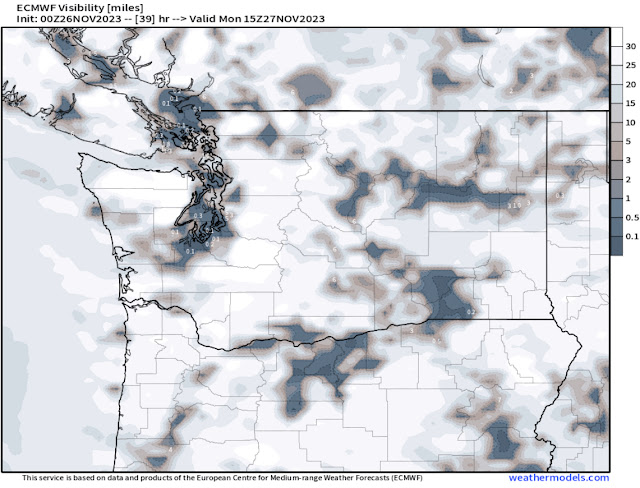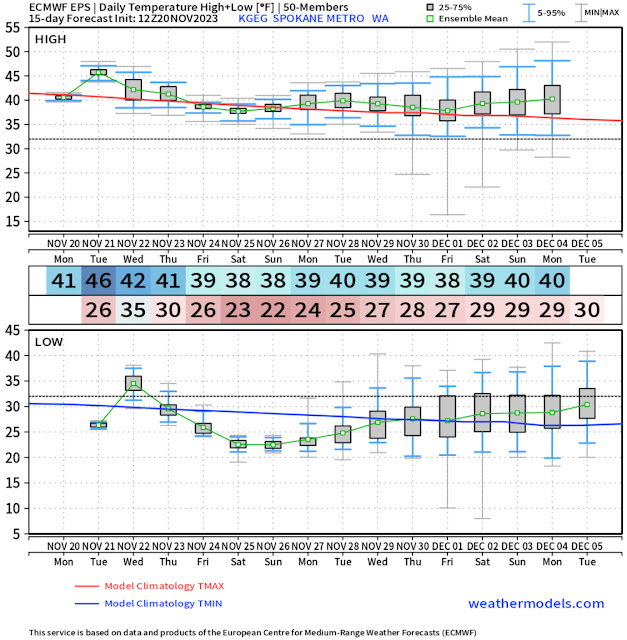FastCast--Friday, Dec. 1 to Sunday, Dec. 3:
A major change in the weather is ahead for the Pacific Northwest, with a very active start to December in the works. The first storm will impact the region from Friday to midday Saturday, bringing significant mountain snow, strong winds, and heavy rain. In the lowlands, expect 0.75-1.4" of rain through Saturday evening, with the potential for less in a rain shadow from Seattle to the San Juan Islands. Snow levels will remain around 2,000-3,000 feet, bringing significant snow amounts of 24-36" to the passes. Travel impacts are expected, especially during the heaviest snow (likely on Friday and into early Saturday). Winds will be breezy on Friday morning (likely gusting 25-35 mph), but stronger winds are expected from late Friday night to early Saturday morning. Forecasts currently show gusts of 40-45 mph during this timeframe. The next system, which will be on the warmer side, arrives on Sunday, bringing another 0.5-1" of rain for the lowlands, plus more strong winds likely gusting 35-45 mph. However, snow levels will rise to near 6,000 feet on Sunday, bringing rain to the passes. This system will increase temperatures in Western Washington to the low to mid 50s. A much more significant atmospheric river is expected early next week, so stay tuned for more updates.
---------------------------------------------------------------
Continue reading the full blog below!
Very active weather is ahead for the Pacific Northwest, as we exit a persistent stagnant and cold pattern. Let's take a look at the forecast.
First, total rain through Saturday evening, seen below on the European model.
This forecast shows 0.75-1.3" for the lowlands through Saturday evening, with a rain shadow noticeable from Seattle north to the San Juans. The coast and Willamette Valley will receive 1.4-2.5" of rain through Saturday.
Let's compare this to the high-resolution NAM forecast, also through Saturday evening.
The NAM forecast shows less rain for the lowlands, with 0.6-1" possible, and a more significant rain shadow from Seattle to the San Juans, with only 0.1-0.4" in the rain shadow. This forecast also gives the coast 1-2" and the Willamette Valley 0.5-1".
Now, let's take a look at the snow forecast for the mountains and Eastern Washington. Below is the European model showing total snow through Saturday night.
This forecast shows the passes receiving 18-36" of snow through Saturday night, bringing significant travel impacts and potential pass closures. Additionally, Eastern Washington gets a region-wide snow event. Cities including Ellensburg, Wenatchee, Moses Lake, Spokane, and Pullman get 2-5", with the Tri-Cities, Yakima, and Walla Walla getting 1-3".
Let's compare this to the NAM high-resolution snow forecast, also through Saturday evening.
This forecast also shows 18-36" of snow for the passes, but paints a different picture for Eastern Washington. According to this forecast, areas closer to the Cascades receive 1-3", with areas further east getting much more. This shows Spokane getting 4-6" and Pullman getting 6-10". This forecast is somewhat less likely, but in the realm of possibility.
Finally, let's take a look at the wind forecast for early Saturday morning, starting with the European model.
Winds will surge as a cold front and associated heavy rain move through the region early Saturday. This forecast (displayed above in knots instead of mph) shows lowland winds gusting 30-45 mph, strongest near the water, with winds reaching 40-45 mph from Whidbey Island northward. The coast would gust 40-50 mph with this forecast.
Let's compare this to the high-resolution HRRR forecast, which shows substantially stronger winds for the whole region.
This forecast shows winds (in mph) gusting 40-50 mph in the lowlands, with localized gusts over 50 mph. The coast would reach 45-60 mph in this forecast, strongest from Ocean Shores southward. This is definitely a possible wind forecast, so stay tuned for more information.
With a lot of active weather and potential forecast changes ahead, I will do another post Friday night, with the latest updates for winds, mountain snow, and rain. Stay tuned!!




















































